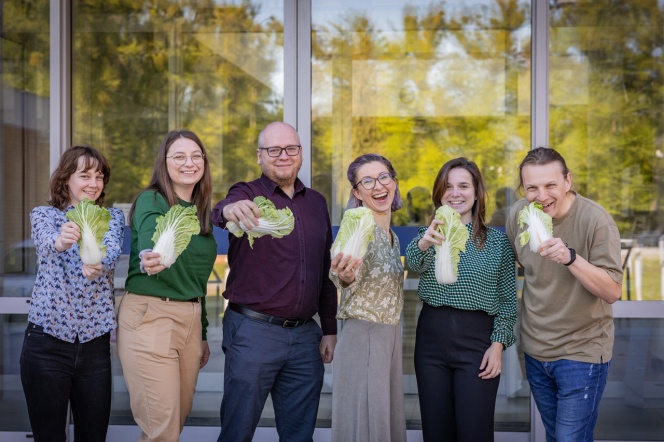Date added: 2025-05-30
Chinese Cabbage Transformed into Sensor Material

The world is currently facing the challenge of enormous volumes of food waste. Managing and recycling such waste constitutes a critical environmental issue that demands innovative and efficient technological solutions. One promising approach involves converting organic waste into valuable products through advanced processes such as pyrolysis – the thermal decomposition of substances in the absence of oxygen.
Based on pyrolysis, members of the interdisciplinary scientific student group RedOX from Gdańsk University of Technology, under the supervision of Prof. Katarzyna Siuzdak (IFFM PAS), Prof. Andrzej Nowak (Gdańsk Tech), and Prof. Jacek Ryl (Gdańsk Tech), undertook the upcycling of Chinese cabbage, i.e., transforming it into a material of higher value.
– The research focused on utilizing cabbage leaves enriched with copper as an organic waste material for the production of activated carbon, which is used in the detection of ascorbic acid (vitamin C). We demonstrated that appropriately processed organic waste can be used in the fabrication of electrode materials for sensors – said Wiktoria Lipińska, PhD, Eng. (IFFM PAS), a graduate of both 1st and 2nd cycle studies at Gdańsk University of Technology.
How much vitamin C is there in fruit juice?

What did the research process involve?
– First, we cut the cabbage leaves into pieces and immersed them in copper salts of varying concentrations. We then subjected them to pyrolysis in an inert atmosphere, producing a carbon-copper powder that was used to modify a glassy carbon electrode. In the next stage, we examined its electrochemical properties in terms of vitamin C detection, which we introduced into the electrolyte in a controlled manner – explained Angelika Łepek, MSc, a doctoral student at the Doctoral School of Gdańsk University of Technology (Faculty of Applied Physics and Mathematics).
– Subsequently, we were able to prove that the material derived from cabbage waste can be effectively used in sensors for food applications, specifically for determining vitamin C concentrations in fruit juices – added Stefania Wolff, MSc, Eng., a doctoral student at the Doctoral School of Gdańsk University of Technology (FAPM) and IFFM PAS.
Publication in a Highly-Ranked Journal and Patent Application
The research outcomes, funded through the TECHNETIUM program, were detailed in the article "Catalytic properties of copper ions enriched cabbage-based carbon materials towards ascorbic acid detection" published in the high-impact journal Sustainable Materials and Technologies (200 points according to the Polish Ministry of Science ranking). These results also led to a patent application.
The research team included members of the RedOX Scientific Circle: Wiktoria Lipińska, PhD, Eng. (IFFM PAS, Gdańsk Tech Graduate, first author of the article), Angelika Łepek, MSc, (FAPM Gdańsk Tech), Stefania Wolff, MSc, Eng., (FAPM Gdańsk Tech and IFFM PAS), as well as Prof. Jacek Ryl (FAPM Gdańsk Tech), Andrzej Nowak, PhD, DSc, Eng., Professor at Gdańsk Tech (FCH Gdańsk Tech), and Katarzyna Siuzdak, PhD, DSc, Eng., Professor at the IFFM PAS, supervisor of the RedOX Scientific Circle and project leader.
Advancing 3D Printing Technology

The RedOX Scientific Circle, operating for the past two years at Gdańsk University of Technology, is the first student scientific organization in Poland affiliated with The Electrochemical Society. This initiative brings together students and doctoral students with interests in electrochemistry, photochemistry, catalysis, and related fields. The group’s aim is to advance knowledge and practical skills in electrochemistry and to conduct both fundamental and applied research. RedOX members are actively involved in the development of various 3D printing technologies for electrochemical applications.
– In the next stages of our research, we plan to incorporate the powders obtained in the described study into a polymer matrix to enable 3D printing of electrodes for sensors – said Prof. Jacek Ryl, RedOX supervisor. – We initiated this line of research as part of a project funded by a Sonata Bis grant.

